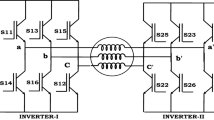Abstract
In this paper, a family of RPWM techniques for the direct torque control (DTC) of open end winding induction motor (OEWIM) drive are presented. The conventional PWM inverters generate high harmonic content and concentrated power spectrum. Using RPWM techniques the harmonic spectrum of inverter is continuously distributed, and thus, the harmonic content in the current waveform is reduced, resulting reduction of ripple in electro-magnetic torque. The simulation results of the DTC of OEWIM drive prove the effectiveness of RPWM techniques in the reduction of the ripple and harmonic contents.

















Similar content being viewed by others
References
Bech, M. M., Blaabjerg, F., & Pedersen, J. K. (2000). Random modulation techniques with fixed switching frequency for three phase power converters. IEEE Transactions on Power Electronics, 15(4), 753–761.
Brahmananda Reddy, T., Amarnath, J., & Subbarayudu, D. (2007). Combining the principles of hybrid SVPWM and DTC for a high-performance induction motor drive for reduced ripple: A variable structure controller approach. In Proceedings of International Conference on Emerging Trends in Electrical Engineering, Kolkata, India.
Brahmananda Reddy, T., Kalyan Reddy, B., Amarnath, J., & Subbarayudu, D. (2006). Space vector based bus-clamping PWM strategies for direct torque controlled induction motor drive without sector and angle estimation using imaginary switching times: A comparative study. In PCEA-IFTOMM International Conference PICA 2006, Nagpur, India, Paper no. TG-327, July 11–14.
Buja, G. S., & Kazmierkowski, M. P. (2004). Direct torque control of PWM inverter-fed AC motors–a survey. IEEE Transactions on Industrial Electronics, 51(4), 744–757.
Busquets-Monge, S., Alepuz, S., Bordonau, J., & Peracaula, J. (2008). Voltage balancing control of diode-clamped multilevel converters with passive front-ends. IEEE Transactions on Power Electronics, 23(4), 1751–1758.
Casadei, D., Grandi, G., Serra, G., & Tani, A. (1994). Effects of flux and torque hysteresis band amplitude in direct torque control of induction machines. In 20th International Conference on Industrial Electronics Control and Instrumentation (IECON), Vol. 1, pp. 299–304.
Casadei, D., Profumo, F., Serra, G., & Tani, A. (2002). FOC and DTC: Two viable schemes for induction motors torque control. IEEE Transactions on Power Electronics, 17(5), 779–787.
Dalessandro, L., Round, S. D., & Kolar, J. W. (2008). Center-point voltage balancing of hysteresis current controlled three-level pwm rectifiers. IEEE Transactions on Power Electronics, 23(5), 2477–2488.
del Toro Garcia, X., Arias, A., Jayne, M., & Witting, P. (2008). Direct torque control of induction motors utilizing three-level voltage source inverters. IEEE Transactions on Industrial Electronics, 55(2), 956–958.
Habetler, T. G., Profumo, F., Pastorelli, M., & Tolbert, L. M. (1992). Direct torque control of induction machines using space vector modulation. IEEE Transactions on Industrial Electronics, 28(5), 1045–1053.
Lai, Y. S., & Chen, J. H. (2001). A new approach to direct torque control of induction motor drives for constant inverter switching frequency and torque ripple reduction. IEEE Transactions on Energy Conversion, 16(3), 220–227.
Na, S.-H., Jung, Y.-G., Lim, Y.-C., & Yang, S.-H. (2002). Reduction of audible switching noise in induction motor drives using random position space vector PWM. IEE Proceedings Electric Power Applications, 149(3), 195–200.
Oh, S.-Y., Jung, Y.-G., Yang, S.-H., & Lim, Y.-C. (2009). Harmonic spectra spereading effects of two phase random centered distribution PWM (DZRCD) scheme with dual zero vectors. IEEE Transactions on Industrial Electronics, 56(8), 3013-3–3013-20.
Patel, C., Dey, R. P. P. A., Dey, A., Ramchand, R., & Kazmierkowski, M. P. (2012). Fast direct torque control of an open-end induction motor drive using 12-sided polygonal voltage space vectors. IEEE Transactions On Power Electronics, 27(1), 400–410.
Satheesh, G., Bramhananda Reddy, T., & SaiBabu, Ch. (2011). DTC of open end winding induction motor drive using the concept of imaginary switching times. In India Conference (INDICON), 2011 Annual IEEE, December 16–18, pp. 1–6.
Satheesh, G., Bramhananda Reddy, T., & SaiBabu, Ch. (2011). Novel SVPWM algorithm for open end winding induction motor drive using the concept of imaginary switching times. IJAST, 2(4), 44–55.
Schulz, D. E., & Kowalewski, D. L. (2007). Implementation of variable-delay random PWM for automotive applications. IEEE Transactions on Vehicular Technology, 56(3), 1427–1433.
Takahashi, I., & Noguchi, T. (1986). A new quick-response and high-efficiency control strategy of an induction motor. IEEE Transactions on Industrial Electronics, 22(5), 820–827.
Takahashi, I., & Ohmori, Y. (1989). High-performance direct torque control of an induction motor. IEEE Transactions on Industry Applications, 25(2), 257–264.
Trzynadlowski, A. M., Borisov, K., Li, Y., & Qin, L. (2005). A novel random PWM technique with low computational overhead and constant sampling frequency for high-volume, low-cost applications. IEEE Transactions on Power Electronics, 20(1), 116–122.
Yao, W., Hu, H., & Lu, Z. (2008). Comparisons of space-vector modulation and carrier-based modulation of multilevel inverter. IEEE Transactions on Power Electronics, 23(1), 45–51.
Zhang, Y., Zhao, Z., Lu, T., & Yuan, L. (2009). Sensorless 3-level inverter-fed induction motor drive based on indirect torque control. In Proceedings of IEEE 6th International Power Electronics Motion Control Conference, pp. 589–593.
Zhang, Y., Zhao, Z., Zhu, J., Xu, W., & Dorrell, D.G. (2009). Speed sensorless direct torque control of 3-level inverter-fed inductionmotor drive based on optimized switching table. In Proceedings of the 35th annual conference of IEEE Industrial Electronics Society, pp. 1316–1321.
Zhang, Y., Zhu, J., Guo, Y., Xu, W., Wang, Y., & Zhao, Z. (2009). A sensorless DTC strategy of induction motor fed by three-level inverter based on discrete space vector modulation. In Proceedings of the Australasian Universities Power Engineering Conference, pp. 1–6.
Author information
Authors and Affiliations
Corresponding author
Rights and permissions
About this article
Cite this article
Satheesh, G., Bramhananda Reddy, T. & SaiBabu, C. A Family of Random PWM Algorithms for Reduction of Torque Ripple and Current Harmonics of Direct Torque Controlled Open End Winding Induction Motor. J Control Autom Electr Syst 25, 349–357 (2014). https://doi.org/10.1007/s40313-013-0105-3
Received:
Revised:
Accepted:
Published:
Issue Date:
DOI: https://doi.org/10.1007/s40313-013-0105-3




